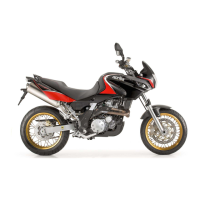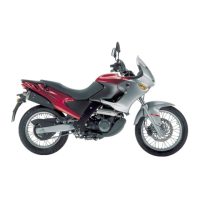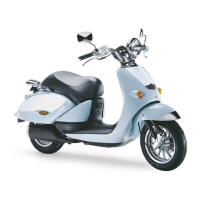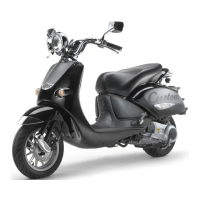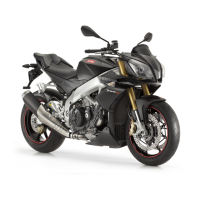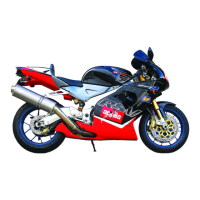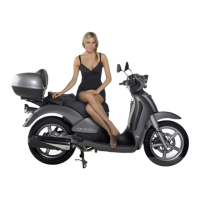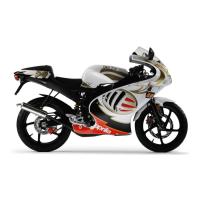
Do you have a question about the APRILIA PEGASO 650 STRADA TRAIL 2005 and is the answer not in the manual?
| Engine Type | Single cylinder, 4-stroke |
|---|---|
| Displacement | 652 cc |
| Bore x Stroke | 100 x 83 mm |
| Starting | Electric |
| Transmission | 5-speed |
| Final Drive | Chain |
| Seat Height | 820 mm |
| Ignition | Electronic |
| Torque | 55 Nm @ 5, 000 rpm |
| Frame | Steel |
| Rear Suspension | Monoshock |
| Front Brake | Single disc |
| Rear Brake | Single disc |
| Cooling system | Liquid |
Explains warning symbols for hazards and provides general safety precautions.
Covers legal requirements, vehicle familiarization, and rider's psychophysical condition for safe riding.
Details protective clothing requirements and guidelines for selecting and installing vehicle accessories.
Provides guidance on loading luggage, distributing weight, and ensuring it is securely fastened.
Identifies and labels the primary external components of the Strada model motorcycle.
Identifies and describes the various controls and instruments located on the handlebars.
Details the function and meaning of various indicators, warning lights, and the multifunction display.
Provides a detailed explanation of each instrument and its function with associated warnings.
Explains the purpose and activation of various warning lights and error indicators.
Explains the multifunction display layout and the operation of the mode selector for navigation.
Details how to access and use the menu, trip meters, and configuration options.
Explains how to set the clock and the gear shift indicator threshold.
Covers adjusting display backlighting and procedures for changing access codes.
Details procedures for code recovery, unlocking safety features, and using the lap timer.
Identifies and explains the function of controls on both the left and right handlebars.
Explains how to lock/unlock the steering and the seat for security and access.
Details how to access the glove compartment and lists the contents of the tool kit.
Provides critical safety warnings and instructions for handling and refueling the vehicle's fuel.
Details the step-by-step process for refueling and post-refueling checks.
Discusses brake fluid properties, system warnings, and safety guidelines for handling.
Explains the operation of disc brakes, fluid levels, and maintenance recommendations.
Guides on checking the front brake fluid level and procedures for topping it up.
Provides detailed instructions for topping up the front brake fluid reservoir safely.
Guides on checking the rear brake fluid level and procedures for topping it up.
Details coolant safety, toxicity, and general maintenance advice.
Provides instructions for checking and topping up the coolant level in the expansion tank.
Explains tyre pressure checks, wear indicators, replacement criteria, and wheel balancing.
Guides on checking engine oil level, warning about low pressure, and topping up procedures.
Details the steps for adjusting the clutch lever free play and associated warnings.
Explains rear brake lever adjustment and provides notes on exhaust silencer types and warnings.
Provides detailed instructions and warnings for safely mounting and dismounting the motorcycle.
Covers riding posture, passenger footrest usage, and instructions for passengers.
Details how to safely get off the vehicle and outlines essential preliminary checks before riding.
Lists components, required checks, and references for performing pre-ride inspections.
Provides instructions for starting the engine, including safety precautions and conditions.
Details clutch, gearbox, and throttle engagement during the engine starting process.
Provides guidance on initial rider and vehicle positioning before moving off, including mirror adjustment.
Explains how to use the clutch, throttle, and gear shift lever for smooth acceleration and gear changes.
Details downshifting procedures, braking techniques, and handling different road conditions.
Provides essential guidelines for the engine running-in period, including speed and RPM limits.
Outlines safe methods for stopping the vehicle and parking it securely.
Explains the correct procedure for placing the vehicle on its side and centre stands.
Offers advice on securing the vehicle against theft and recording owner information.
Provides essential safety guidelines and precautions to follow before and during maintenance operations.
Outlines scheduled maintenance tasks and their intervals, with a key to service symbols.
Lists maintenance operations that must be performed by an authorized Aprilia dealer, with service intervals.
Explains how to find identification numbers and provides instructions for handling click and screw clamps.
Guides on checking engine oil level, warning about low pressure, and topping up procedures.
Provides step-by-step instructions for safely removing the front wheel.
Details the steps for reassembling the front wheel, including torque specs and final checks.
Provides step-by-step instructions for safely removing the rear wheel.
Details the steps for reassembling the rear wheel, including flexible coupling checks.
Covers final steps in rear wheel reassembly, including brake checks and component cleanliness.
Explains how to safely position the vehicle on rear and front support stands.
Details procedures for checking chain slack and adjusting chain tension.
Covers checking chain and sprocket wear, and provides guidelines for cleaning and lubricating the chain.
Details removal of oil sump and chain guards, and explains rear suspension adjustment.
Guides on adjusting rear shock absorber settings for different riding conditions, including a table of settings.
Provides instructions and criteria for checking the wear on front and rear brake pads.
Guides on checking engine idling speed and adjusting it if necessary, with safety warnings.
Provides instructions for removing, cleaning, and inspecting the spark plug for wear and deposits.
Guides on installing the spark plug, checking and adjusting the gap, and ensuring proper connection.
Details safety precautions for handling the battery, including fire risks and cable connection order.
Details the steps for safely removing the battery, including precautions for storage.
Explains how to charge the battery and the correct procedure for reinstalling it.
Explains how to check fuses, replace them, and lists the location and rating of each fuse.
Details how to adjust the headlight beam vertically and mentions instrument panel lighting.
Provides instructions for changing headlight bulbs and general safety precautions for bulb replacement.
Details the procedure for replacing individual headlight bulbs: high beam, parking, and low beam.
Covers replacing the number plate bulb, transport precautions, and general cleaning advice.
Provides detailed instructions for washing the vehicle, including safety precautions and cleaning agents.
Outlines necessary precautions and procedures for storing the vehicle during long periods of inactivity.
Details actions to take after a period of inactivity, including checks and a test ride.
Provides detailed technical specifications for the vehicle's dimensions, engine, transmission, and fluid capacities.
Lists specifications for gear ratios, drive chain, fuel system, frame, suspensions, brakes, wheels, and tyres.
Lists specifications for tyres, ignition, spark plugs, electrical system components, bulbs, and warning lights.
Details recommended engine oil, fork oil, greases, brake fluid, and coolant types.
Presents the electrical wiring diagram for the Pegaso 650 I.E. model.
Provides a key to the wiring diagram components and lists the standard cable color codes.
Emphasizes the value of authorized service, genuine parts, and proper vehicle maintenance.
